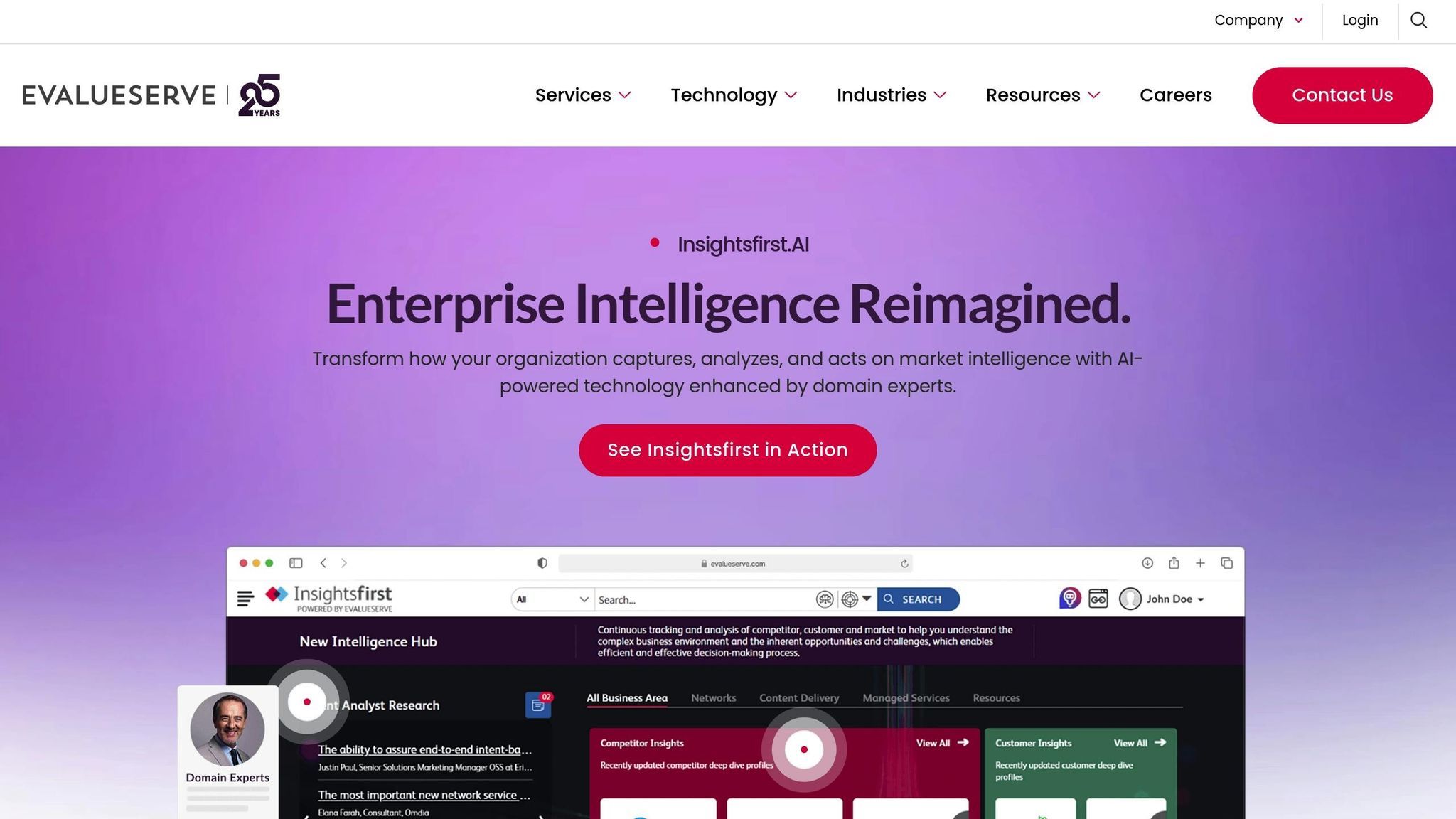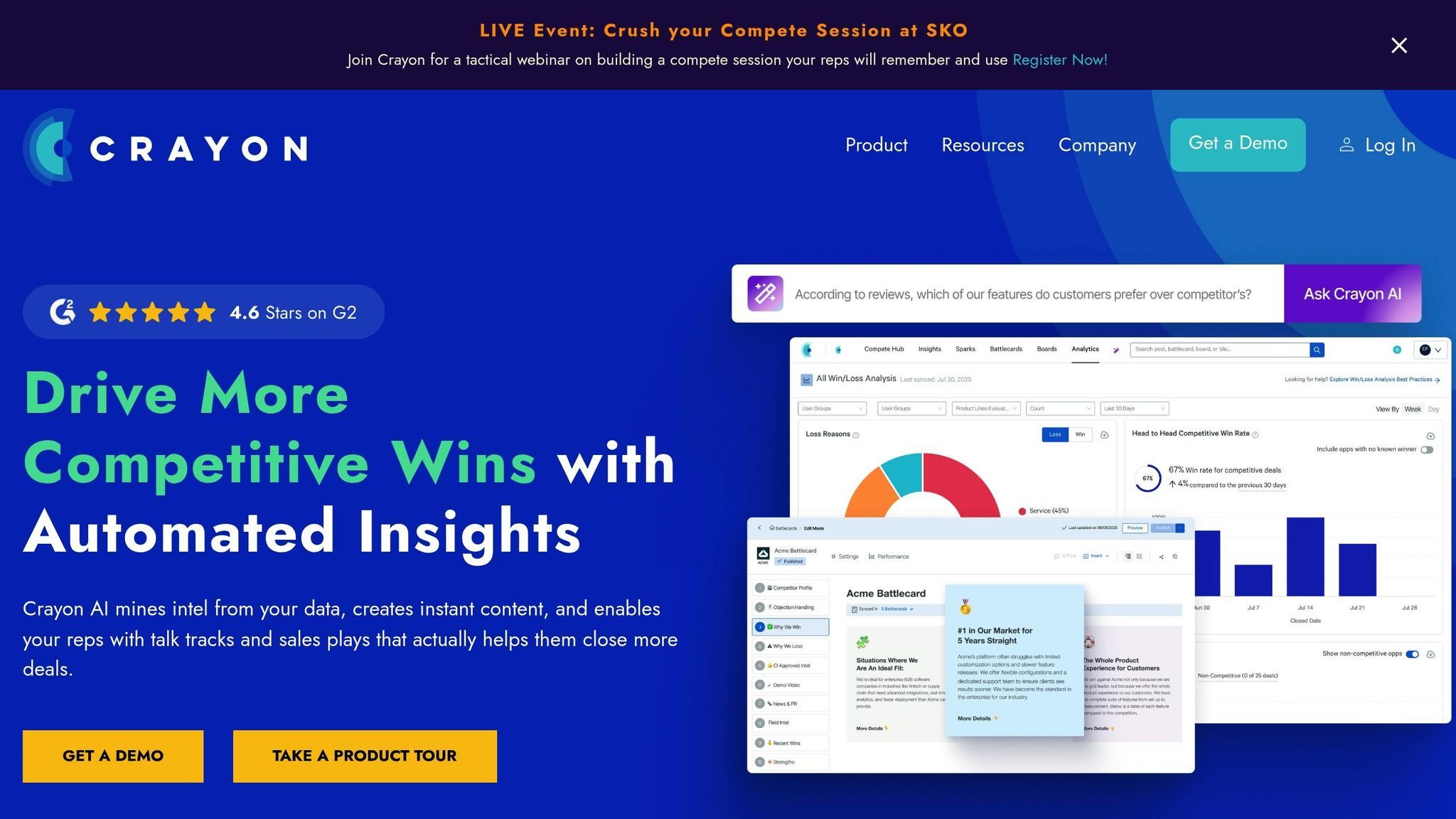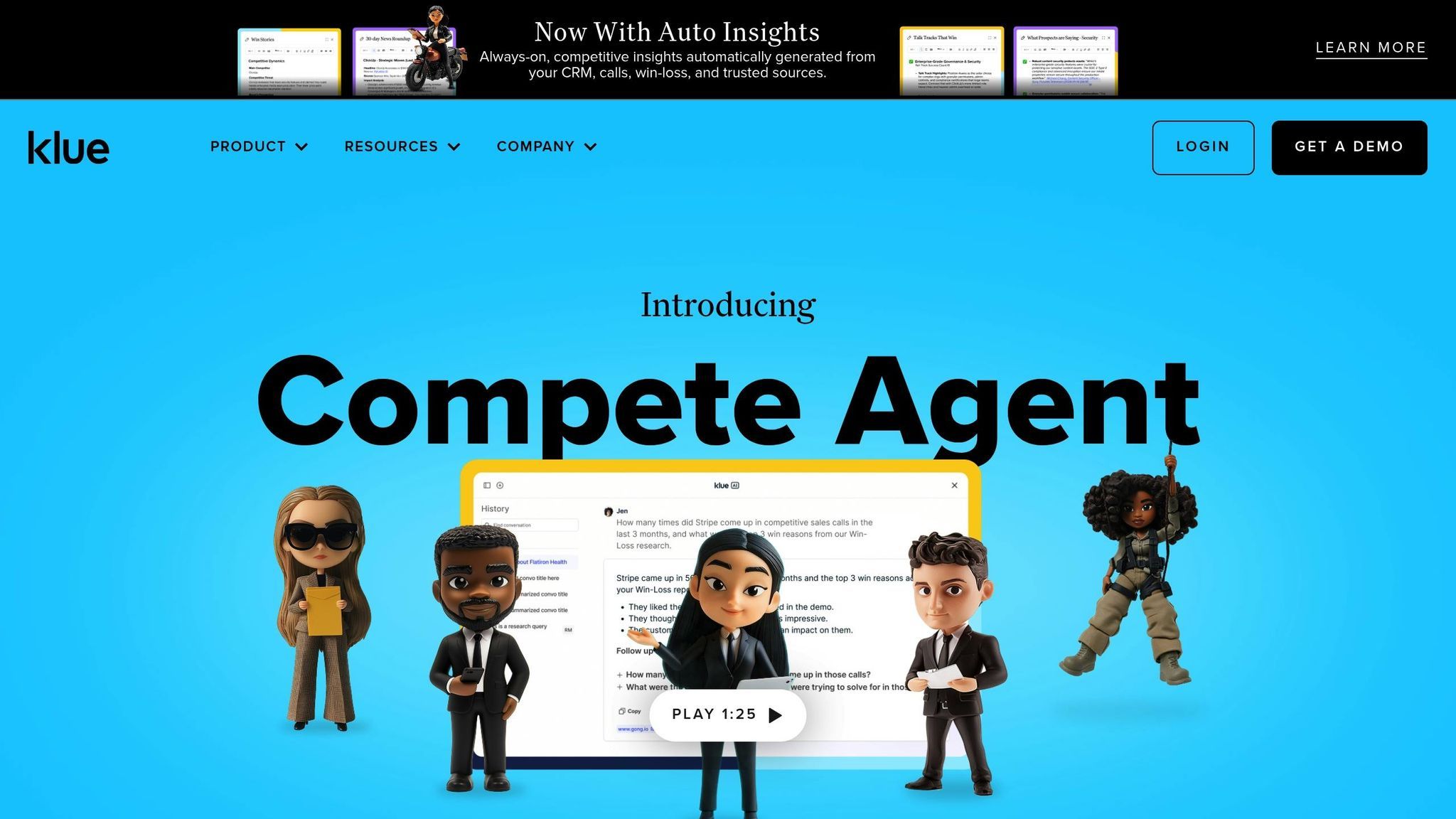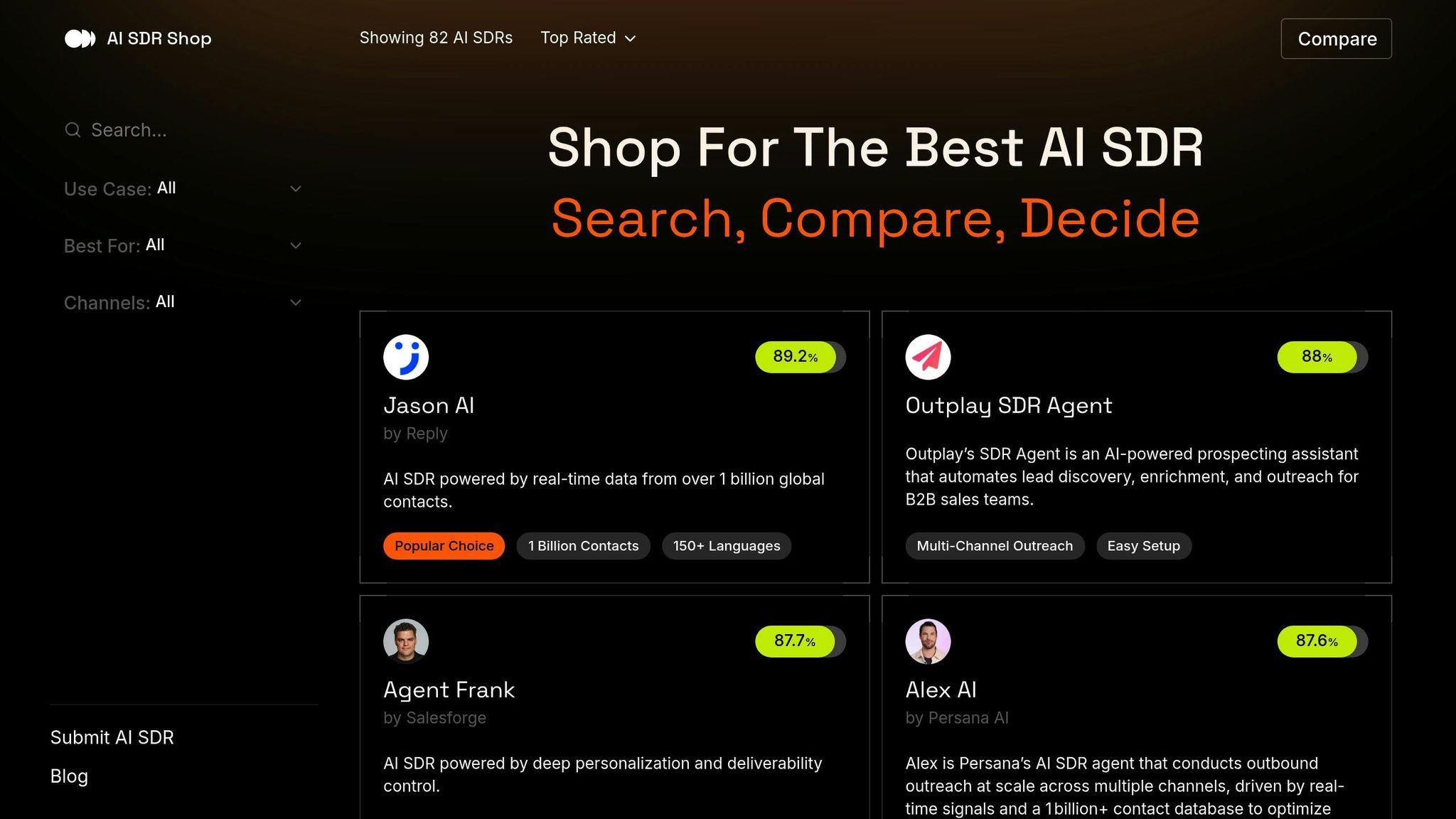Competitive Intelligence Tools for Sales Teams 2025

Competitive Intelligence Tools for Sales Teams 2025
Want to win more deals in 2025? Competitive intelligence (CI) tools are now a must-have for sales teams. These tools track competitors in real-time, analyze market trends, and deliver actionable insights directly into your workflow. Here's what you need to know:
What CI Tools Do: Monitor competitor pricing, product updates, social media, and customer sentiment to help sales reps respond faster and smarter.
Why 2025 Matters: Advances in AI have made CI tools faster and more precise, allowing sales teams to stay ahead in a rapidly changing market.
Top Tools:
Crayon: Tracks competitors' moves with AI and integrates well with CRMs. Starting at $8,000/year.
Klue: Simplifies data for sales teams and offers CRM integration. Starts at $129/month.
Insightsfirst: Combines competitor tracking with strategic insights for both sales and marketing teams.
Key Benefits: Teams using CI tools report faster sales cycles, better objection handling, and higher win rates. Integration with CRMs like Salesforce ensures insights are always at your fingertips.
How to Get Started: Audit your sales process, choose a tool that fits your budget and needs, and run a pilot program to test its effectiveness. For more options, check out the AI SDR Shop, which lists over 80 sales tools.
Bottom Line: In 2025, staying competitive means using real-time intelligence to guide your sales strategy. These tools help you close deals faster and beat the competition.
How to use sales and competitive intelligence to win bigger deals and scale growth
::: @iframe https://www.youtube.com/embed/1qt1fmzKO34 :::
Key Parts of Competing Tools
Today's tools for competing watch and study what rivals do, giving sales groups a big leg up. These systems aim to turn basic info into useful tips, helping groups make faster, smarter choices to stay in front.
Watching Rivals Live
These tools keep an eye on rivals by watching their sites, social posts, price moves, and new items. For example, setups like Crayon and AlphaSense pull info from many places and give your sales group daily AI-run summaries. This steady flow of news means your team can shift fast if a rival changes their plan. This is a big plus - groups using tools like LinkedIn Sales Navigator have seen a 312% ROI over three years and a 16% increase in wins.
Self-updating Cards
Self-updating cards change as your rivals change. Tools like Kompyte and Crayon keep these cards fresh by changing them as rivals change their words, add new bits, or shift their spots. Since these cards tie right into your CRM, they give your group up-to-date ways to talk and plans to beat pushback - all aimed at the latest market moves.
AI-run Words and Feel Checks
Top CI tools also look deeper by studying how the market feels about rivals. Using tech that reads and understands language, they check rival words, social posts, and buyer words to find good messages and trends. This study shows where there are gaps in words and new chances. For example, if feel checks show buyers are upset with a rival’s help, your group can stress your own strong help. Firms using tools like Cognism’s sales info have seen a 40% rise in good leads and a 25% boost in winning sales. These insights shape your sales talk, giving your group a better edge.
Top Simple Tools for Sales Teams
Here are three easy-use tools that bring smart competitor info right into sales tasks, making them key for sales teams.
Insightsfirst

Insightsfirst mixes AI-led studying with top know-how to keep sales teams on top of market shifts. It has a look-up info base, changeable screens, and smart tips that add important details. A big plus is its auto SWOT check and match tools, which aid teams get set for new product starts and spot big chances that could miss out. Also, it works well with big CRMs, making sure details are right there. Now, let’s look at a tool made for non-stop checks.
Crayon

Crayon is great at watching every move of rivals in real time, by keeping an eye on changes in their sites, social media, prices, and products. Its AI tool, Sparks, gives more than 100 useful points using brief checks and odd spot find. Crayon also works with tools like Salesforce and Slack, making it simple to use these points every day. The price starts at $8,000 per year.
Klue

Klue aims at getting rival info from many spots and making it into clear game plans for sales teams. It takes info from rival sites, buyer thoughts, social media, and news, updating these game plans to keep up with fresh info. The tool’s mood check helps teams know how buyers see rivals by summing lots of reviews and seeing big waves. Quick wraps of rival changes mean sales folks can get to need-to-know info about rival talks and buyer views before big meets. Many say that Klue makes getting to insights faster and boosts the quality of sales chats.
These tools don’t just hand out plain numbers - they fit smart points right into sales tasks. By syncing with CRMs and team tools, they become a normal part of daily sales work.
For teams looking at smart sales tools, AI SDR Shop lists more than 80 AI SDR helpers and smart sale tools. This guide has feature face-offs, link choices, and real-use tips to help U.S. companies pick the best pick for their goals and money plans.
sbb-itb-4c49dbd
Putting Auto Rival Content Checks into Sales Steps
As we saw, knowing what rivals do is key to win in sales. Auto tools add this info into daily tasks. For sales groups, having new updates on rivals can change the game, as doing this by hand takes too much time. Auto tools that check rival content fix this by watching their moves and giving useful tips right into sales steps. This non-stop watch builds the base for smarter, more joined plans.
Watching Rival Messages and Product Shifts
Auto tools with AI keep an eye on updates from rival sites, social media, and news as they come. These tools use connectors and crawlers to fully cover many places. More than just watching, some tools study rival word use, ad buys, and buyer talks, showing a full view of market moves. When big changes happen, fast alerts and reports pop up. Plus, AI that gets the feel of rival talks and posts can spot new trends, be they good or bad.
Tying Tips to Sales Places
The next step is to get these tips to where sales groups work. Tools that know rival moves blend well with CRMs like Salesforce and HubSpot, and sales tools. Things like battlecards, rival scores, and quick reports can go right into CRM logs or be shared through tools like Slack. This makes sure sales folks get the tips they need without stopping their flow. Links with tools like Slack and Microsoft Teams make sure updates and alerts come fast. These links help sales teams use the tips and cut down the need for by-hand checks.
Better Answering Problems with New Info
Having new rival info ready changes how sales reps handle problems. Instead of just reacting, they can get ahead with info-based answers. For example, if a rival drops a new thing during a sales cycle, auto battlecards can right away give talk points or show how our product is better to fight their claims. These tools also back up win/loss checks and plans for facing rivals, helping teams shape their messages to face rival strong and weak spots well. Alerts for key rival moves - like price changes, new products, or ad runs - make sure sales reps always have new info when they talk to buyers.
For groups wanting to up their game in knowing rivals, AI SDR Shop is a great spot. This list has details on over 80 AI-based Sales Rep tools, letting users search, weigh, and pick tools based on what they do, how they connect, and special needs. It’s a handy way to find the right SDRs to fit well into your sales steps.
Looking at Tools for Competing Well: What They Do and When to Use Them
Picking the best tool to know your rivals needs thought on your team's main wants, money limit, and what tech you already use. The top picks - Crayon, Klue, and Insightsfirst - each have their own strong points that fit well with various sales needs and team sizes.
Main Parts and How They Fit Together
All three tools do the basic job of keeping an eye on rivals, but they shine in different ways. Here's what each one does best:
| Tool | Live Checks | Auto Cards | AI Text Check | CRM Link | Own Reports | Best for |
|---|---|---|---|---|---|---|
| Crayon | Yes | Yes | Yes (Sparks AI) | Yes | Yes | Sales help teams |
| Klue | Yes | Yes | Some | Yes | Yes | Sales groups |
| Insightsfirst | Yes | Yes | Yes | Yes | Yes | Sales/marketing teams |
Crayon shines with its Sparks AI, catching over 100 key points like new stuff from rivals, price changes, and ad moves. This marks it good for teams in tough market fights.
Klue makes it easy for sales folks by putting its battlecards right in the tools they already use. This smooth mix means info is on hand in live sales talks, making it top for teams that find it hard with new CI tools.
Insightsfirst steps up with tailored boards and help from top minds. This mix of sales and marketing help is good for firms that need both big plans and clear, next steps.
Prices and Best Uses
Knowing the costs and best times to use these can help pick the right tool for your team:
| Tool | Cost (USD) | Who it's for | Best Use Case |
|---|---|---|---|
| Crayon | Cost changes | Medium to big firms | Teams who look deep into rival moves |
| Klue | Begins at $129/month | Small to big firms | Sales groups who need smooth CRM mix |
| Insightsfirst | Cost changes | Medium to big firms | Groups who want help plus facts together |
For small to medium businesses, Klue's starting price of $129 per month is often easy to get, great for teams aimed at sales help. Its clear battlecards bring quick wins without too much for smaller teams.
Big groups tend to go for Crayon or Insightsfirst. These tools meet big needs with top automation and full reach. For example, big firms like HubSpot and Marketo have used Crayon to make sales plans better, deal with pushbacks, and speed up deals[1]. The custom price for these setups often leads to clear gains in how well they do.
Mid-size firms should check their own needs before picking. Teams all about sales help tend to like Klue, while those that need wide know-how for both sales and marketing might like Crayon or Insightsfirst more.
Using AI SDR Shop for Sales Tool Pick

After looking at CI tools, think about bettering your sales step by adding them with AI-driven SDR tools. AI SDR Shop, a free list site, lets users look up and weigh over 80 AI-driven SDR agents by what they do, how they mix, and how they're used.
This site is very useful when matching CI tools with AI SDRs. Many new AI SDRs now mix in rival know-how in their steps, letting them tweak messages based on what rivals do. For instance, some AI SDRs can tailor talks by using info from tools like Crayon or Klue.
With AI SDR Shop, sales teams can fast find SDR tools that match their CI setup, making the sales tech stack smoother. The result? A more joined, easy way to find and reach out - all with no long checks of sellers. By joining CI tips with AI SDR skills, teams can be more sharp in rivalry and get better results.
Conclusion: Selecting the Right Competitive Intelligence Tool in 2025
Competitive intelligence has come a long way. With AI-driven automation and real-time data delivery, sales teams are now equipped to act immediately on competitor activity. In 2025, success hinges on selecting tools that seamlessly integrate with your current sales processes while delivering insights exactly when you need them. These advancements empower teams to make smarter, faster decisions that directly impact sales performance.
Key Takeaways for Sales Teams
Today's competitive intelligence tools provide powerful features like real-time competitor tracking, automated battlecards, and AI-powered content analysis. These capabilities enable sales teams to respond more quickly to market changes, handle objections more effectively, and boost win rates by staying one step ahead of competitors.
By using these tools strategically, teams can anticipate competitor actions, refine their messaging, and adapt to market shifts faster than those still relying on manual research. Integration is key - embedding competitive intelligence directly into your CRM and sales tools ensures that your team can access critical updates and battlecards without disrupting their workflow, leading to higher adoption and better results.
Metrics like win/loss rates, sales cycle duration, objection resolution rates, and the speed at which competitor moves are identified are essential to measure success. For instance, one sales team achieved a 15% increase in win rates after incorporating real-time updates into their process [2].
To fully capitalize on these benefits, it's important to focus on implementation strategies that align with your team's goals and workflows.
Next Steps for Implementing CI Tools
Start by auditing your sales processes to identify gaps in intelligence that may be slowing down deals or causing missed opportunities. Clearly define your sales objectives and workflow needs before choosing a competitive intelligence platform to ensure it fits seamlessly into your team's operations.
Look for tools that offer real-time competitor tracking, automated battlecards, and easy integration with your CRM and other sales platforms. The best tools deliver insights directly into your existing workflow, eliminating the need for extra logins or manual data entry.
To simplify the selection process, consider using resources like AI SDR Shop, which provides a directory of over 80 AI-powered SDR agents. This free tool helps organizations compare features and integrations, making it easier to enhance both competitive intelligence and sales development capabilities.
Before committing to a tool, run a pilot program with your top choices. Gather feedback from users to refine your selection and implementation. Keep an eye on usage data and input from your sales team to continuously optimize your setup and maximize your return on investment.
Finally, even the most advanced CI tools require ongoing education. Ensure your sales reps are trained not just on how to use the tools but also on how to apply the insights during live sales conversations. Continuous learning and enablement should be a core part of your strategy to ensure your team gets the most out of their competitive intelligence tools.
FAQs
How can competitive intelligence tools work with CRM systems to improve sales performance?
Competitive intelligence tools work hand-in-hand with CRM systems, delivering valuable insights directly to sales teams. These tools dig into competitor data, market trends, and customer behavior, feeding your CRM with up-to-date information that helps sales reps fine-tune their strategies. For example, features like automated competitor content analysis can be embedded into CRM workflows. This allows sales teams to spot new opportunities, foresee potential obstacles, and craft personalized outreach efforts. By integrating these tools seamlessly, sales reps gain access to the data they need, exactly when they need it, leading to greater efficiency and higher success rates.
What features should sales teams prioritize when choosing a competitive intelligence tool in 2025?
When choosing a competitive intelligence tool in 2025, sales teams should prioritize features that simplify processes and deliver practical insights. Tools with automated competitor content analysis are a must-have, as they can track and summarize important updates from competitors, saving valuable time. Another key feature to look for is real-time alerts for market shifts and competitor activities, which can help you stay ahead in fast-moving industries. It's also important to pick a tool that integrates smoothly with your current sales platforms, like CRM systems, to boost efficiency. If you're considering AI-powered options, platforms such as AI SDR Shop can guide you in finding tools that match your specific needs, offering detailed comparisons of features and applications.
How can sales teams track the effectiveness of competitive intelligence tools on their performance?
Sales teams can gauge how well competitive intelligence tools are working by keeping an eye on key performance indicators (KPIs) like win rates, deal velocity, and conversion rates. These numbers reveal how effectively the tools are helping the team spot opportunities and close deals faster. Another way to evaluate these tools is by examining how frequently competitor insights shape sales strategies or decisions. Gathering regular feedback from the sales team and conducting periodic performance reviews can further clarify whether the tools are providing meaningful results.